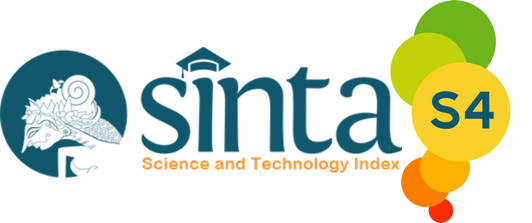The Need Analysis of Learning Module Development Using Self Organized Learning Environment (Sole) Assisted by Augmented Reality on Rotational Dynamics and Rigid Body Equilibrium
DOI:
https://doi.org/10.33369/ijier.v1i1.14112Keywords:
Augmented Reality, learning media, Self Organized Learning Environtment (SOLE)Abstract
This study aims to analyze the need for the development of learning module using the Self Organized Learning Environment (SOLE) model assisted by Augmented Reality on rotational dynamics and rigid body equilibrium. This type of research is a survey research and literature study which later can be the basis for further development research. The research instrument used was a needs analysis questionnaire with 20 questions given to 72 respondents who were students and 3 respondents who were teachers of class XI MIPA from SMA Negeri 5 Bengkulu City, SMA Negeri 4 Bengkulu City and SMA Negeri 9 Bengkulu City. In this research the data analysis uses descriptive statistics. Based on the results of the data obtained it can be concluded that currently students are in dire need of computer-based learning media, one of which is by using Augmented Reality. This is based on data obtained that 76,26 % of students answered Strongly Agree and 77,92 % of teachers answered Strongly Agree to the need for the development of the development of learning module using the Self Organized Learning Environment (SOLE) model assisted by Augmented Reality on rotational dynamics and rigid body equilibrium. We know that the development of digital technology in the current Industrial 4.0 era has brought changes and influenced various aspects of human life, including in the field of education. Augmented Reality are technologies that can be developed to provide alternative instructional media provided previously and to see the effectiveness of these media if used in learning activities.
References
Anggitasari, M., Tarwana, W., Febriani, R. B., & Syafryadin, S. (2020). Using Wattpad to Promote the Students’ Responses to Literary Works: EFL College Students’ Perspectives and Experiences of Enjoying Short Stories. Jadila: Journal of Development and Innovation in Language and Literature Education, 1(2), 182-192.
Azwandi, A., Harahap, A., & Syafryadin, S. (2019). Penyuluhan dan pelatihan ict-enhanced teaching–learning sebagai model pengembangan profesional guru di kota Bengkulu. Jurnal Pengabdian Masyarakat Ilmu Terapan (JPMIT), 1(1).
Ani, I. (2019). Membuat Sendiri Aplikasi Augmented Reality. Cianjur: PT Elex Media Komputindo.
Daniel, I. (2019). Rancang Bangun Sistem Pembelajaran Model SOLE (Self Organized Learning Environment) Berbasis Web Dengan Gaya Belajar Vak Untuk Meningkatkan Pemahaman Kognitif Siswa. 1–12.
Fatwatush, S.A. (2019). Pembelajaran Self-Organised Learning Environment (SOLE) Dalam Penyelesaian Tugas Di Smp Negeri 9 Semarang.
Handayani, E.T.Y., & Nursetiawati, S. (2020). Pengembangan Modul Pembelajaran Sanggul Modern. Jurnal Ilmiah Wahana Pendidikan, 6(3), 317–322.
Handayani, S., Youlia, L., Febriani, R.B., Syafryadin, S. (2020). The use of digital literature in teaching reading narrative text. Journal Of English Teaching, Applied Linguistics And Literatures (JETALL). 3(2), 65-74.
Isnawati, A. (2017). Pengembangan Buku Ajar Dan Augmented Reality (Ar) Pada Konsep Sistem Pencernaan.
Irzain, R. A., Irfansyah, & Hindersah, H. (2017). Analisis Virtual Guide Monument Kapal Selam Surabaya ( Monkasel ) Melalui Penggabungan “ Google Cardboard ” Dan Augmented Reality. Jurnal Komunikasi Visual & Multimedia, 8(1), 13–35.
Hakim, L. (2018). Pengembangan Media Pembelajaran Pai Berbasis Augmented Reality. Lentera Pendidikan : Jurnal Ilmu Tarbiyah Dan Keguruan, 21(1), 59–72.
Kemendikbud RI. (2013). Peraturan Menteri Pendidikan Dan Kebudayaan Nomor 69 Tahun 2013 Tentang Kerangka Dasar Dan Struktur Kurikulum Sekolah Menengah Atas/Madrasah Aliyah.
Mitra, S., & Crawley, E. (2014). Effectiveness of Self-Organised Learning by Children: Gateshead Experiments. Journal of Education and Human Development, 3(3), 79–88.
Prastowo, A. (2015). Panduan Kreatif Membuat Bahan Ajar Inovatif (VIII). Yogyakarta: Diva Press.
Putri, R. M., Risdianto, E., & Rohadi, N. (2019). Pengembangan Media Pembelajaran Interaktif Dengan Menggunakan Adobe Captivate Pada Materi Gerak Harmonik Sederhana. Jurnal Kumparan Fisika, 2(2), 113–120.
Risdianto, E., & Kusuma, A. B. (2016). Pembuatan Multimedia Interaktif Teknik Operasional Spss 22. Prosiding Seminar Nasional Fisika (E-Journal) SNF2016, 5, 95–102.
Septinawati, S., Febriani, R.B., Tarwana, W., Syafryadin, S. (2020). Students’ Perceptions Toward the Implementation of Quipper School as an E-Learning Platform in Teaching English. Jadila: Journal of Development and Innovation in Language and Literature Education. 1(2), 223-238.
Sugiyono. (2010). Metode Penelitian Pendidikan (Pendekatan Kuantitatif, Kualitatif, dan R&D). Bandung: Alfabeta.
Syafryadin, S., Pratiwi, V. U., & Wardhana, D. E. C. (2021). Pre-service English teachers' experience with various CALL applications: Hindrances and reflection. Studies in English Language and Education, 8(1), 99-114.
Yudhi, P. (2017). Analisis Kebutuhan Pengembangan Lembar Kerja Siswa Berbasis Realistics Mathematics Education (Rme) pada Materi Fpb dan Kpkk untuk Siswa Kelas IV Sekolah Dasar. Menara Ilmu, 9(74), 144-149.
Siahaan, A. D., Medriati, R., & Risdianto, E. (2019). Pengembangan Penuntun Praktikum Fisika Dasar Ii Menggunakan Teknologi Augmented Reality Pada Materi Rangkaian Listrik Dan Optik Geometris. Jurnal Kumparan Fisika, 2(2), 91–98.
Downloads
Published
How to Cite
Issue
Section
License

Ciptaan disebarluaskan di bawah Lisensi Creative Commons Atribusi-BerbagiSerupa 4.0 Internasional.







